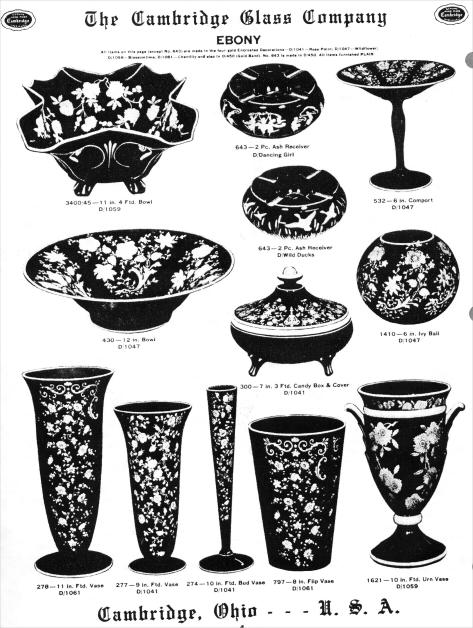Ebony, Part II
by Mark A. Nye
Issue No. 250 - February 1994
This is how the CGL writers described a Cambridge table setting illustrated in the April 1930 issue:
"...The ware shown is by the Cambridge Glass Co., of Cambridge Ohio. Their black glass is known as 'Ebony.' The center arrangement is made up of swans in 'Ebony' glass with a large swan as a flower holder and smaller swans as candle holders. The flat ware [Decagon plates] is in 'Ebony' glass while the cup is in crystal, contrasting with the black saucer. Crystal bowls in optic design with 'Ebony' stem and foot are used for the [No. 3115] stemware." The following month a Cambridge advertisement featured No. 3115 stemware etched No. 742. Quoting from the advertisement: "The stems and feet are in 'Ebony,' a shimmering black." Later that same year, the November Cambridge advertisement featured No. 3130 stemware and the text speaks for itself: "A Striking Combination. The gorgeous Apple Blossom Etching on Crystal with Ebony Stem and Foot Offers Merchandise of Extraordinary Appeal."
In 1931, Ebony continued to play a feature role in the Cambridge line. Among the catalog pages issued in 1931 as supplements to the 1930 Cambridge catalog are three captioned "Ebony Silver Decorated Ware." [These pages are numbered 31-10, 31-11 and 31-12 in the NCC Inc. reprint of the 1930-34 Cambridge catalog.] Quoting from the April 1931 issue of CGL:
"...With this firm it has become a habit to continually design and produce new items and lines. Their latest production is silver on ebony which is shown in a range of fancy pieces, such as various sizes and shapes in vases, cocktail shaker, console sets, relishes, etc...."
Besides these items, the 1931 catalog pages offered cream and sugar sets, an ice bucket and various trays and plates. The basic form of decoration was silver encrustation of etched ware with the addition of silver rims, bases and a few lines. Among the etchings used for silver decorated ware are Apple Blossom, Lorna, Gloria, Windsor Castle and No. 739. Appearing further along in the 1931 catalog supplement were two pages captioned "Ebony Silver Decorated Ware Sport Novelties." [Pages 31-27 and 31-28 in the NCC reprint] Both silver encrusted etchings and silver deposit designs appeared on these pages. The majority, if not all, of the silver decorated items were out of the Cambridge line by the late 1930s, if not earlier.
From time to time a plain Ebony etched item will be found. Besides the etchings listed above, I have seen Cleo, No. 741 and No. 743 on Ebony blanks. Ebony blanks with other etchings are also possible.
Nowhere in the 1930 catalog or its supplements is there any reference to gold decorated ware of any kind, much less gold decorated Ebony blanks. It is possible some Ebony blanks decorated with silver were also encrusted with gold as Cambridge was doing gold encrustations during the early 1930s. Pictured in Colors in Cambridge Glass is a No. 1025 six-inch cigar humidor with gold encrusted Hunt Scene as is a No. 1023 cocktail shaker with the gold decoration D/185 dancing girls and a tray with a gold encrusted dog.
While it appears Ebony remained in the Cambridge line until at least the early 1940s, it no longer received the attention it did during the late 1920s and early 1930s. By 1940, although Ebony continued to appear in Cambridge color listings, production was apparently limited to a few undecorated smokers items.
Two undated catalog pages, probably supplements to the 1940 catalog, suggest Cambridge attempted to revive interest in Ebony ware in the early 1940s. These pages are the only Cambridge reference to gold encrusted etchings on Ebony blanks. Except for the #643 2-piece ash receiver, all of the blanks shown on the first page were made in gold encrusted Rose Point, Wildflower, Chantilly and Blossomtime. According to the fine print of the caption, production of the ash receiver was limited to D/Dancing Girl and D/Wild Ducks. On the second page only Nos. 646, 647, 648/19 and 1268 were offered with these gold encrusted etchings. All of the items, except the Scotty Dog, came with the decoration known as D/450-Gold Band Decoration.
The June 1949 Cambridge catalog offered nothing in Ebony. Production of the color resumed before September 1950 and two supplemental catalog pages showing Ebony colored glassware were added to the catalog. [Pages 148C and 148D in the NCC reprint of the 1949-53 catalog] Sold plain only, Ebony continued in the Cambridge catalog until the fall of 1953.
Early in 1954 Ebon, a matte finished black glass, replaced Ebony. Found plain and with stylized gold decorations, its production ceased with the factory closing the following summer.
Little information about gold decorated Ebony is available. Collectors having gold decorated Ebony items not mentioned in this article are urged to share the information with their fellow members. Simply write a note to Editor or myself and we will see that it is published in a future issue.


